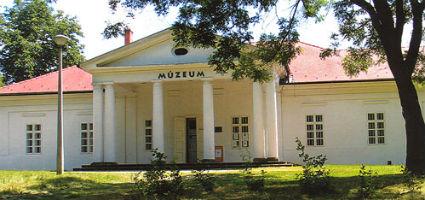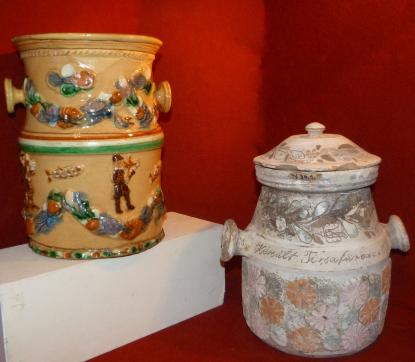2024. May 6. Monday
Pál Kiss Museum - Tiszafüred
 |
Address: 5350, Tiszafüred Tariczky sétány 6.
Phone number: (59) 352-106
E-mail: kisspalmuz@gmail.com
Opening hours: Tue-Sat 9-12, 13-17
|
The exhibition has closed for visitors.
2015.07.01. - 2015.07.31.
Museum tickets, service costs:
|
Ticket for adults
|
500 HUF
|
/ capita
|
|
Group ticket for adults
(min. 10 people)
|
150 HUF
|
/ capita
|
|
Ticket for students
|
250 HUF
|
/ capita
|
|
Ticket for pensioners
|
250 HUF
|
/ capita
|
|
Ticket for families
(2 adults + max. 3 children)
|
750 HUF
|
/ family
|
|
Program ticket
|
300 HUF
|
/ capita
|
|
Season ticket
|
1000 HUF
|
|
|
Group guide
(max. 40 people)
|
2000 HUF
|
/ group
|
|
Photography
|
1000 HUF
|
|
|
Video
|
1000 HUF
|
In our show-case we display two traditional, circular ceramic vessels of flour. These pots were used for storing flour in the pantry of a traditional household. One of these colorful ceramic flour containers was made in Mezőtúr (in Hungary) at the end of 19th century. It was the classical era of Mezőtúr pottery. This glazed wessel has floral, colorful decorations. The basic colour is a special yellow, the so-called dudi-yellow (“dudisárga”), which was named after a small village, where this earth colour was mined. It is a shiny glazed ceramic as it passed through the second phase of firing process: after the first “terracotta firing” lead glaze was poured over the whole vessel and the final firing followed.

The other ceramic vessel of flour was made in 1939, in Tiszafüred in the workshop of Tüdős, Kálmán (1908-1989). In the 19th century Tiszafüred was an important centre of popular hand-made pottery in Hungary, but Tüdős worked during the decline of this traditional hand-made pottery in Tiszafüred. He worked with traditional, but rather simple Tiszafüred-motives easy to make. This vessel was passed through only the first part of the firing phase. It is the so-called zsengélés, the terracotta firing, when the designs get their colour. That is why it has not got a shiny glazed colour on the surface.
Translated by Vadász, István

The other ceramic vessel of flour was made in 1939, in Tiszafüred in the workshop of Tüdős, Kálmán (1908-1989). In the 19th century Tiszafüred was an important centre of popular hand-made pottery in Hungary, but Tüdős worked during the decline of this traditional hand-made pottery in Tiszafüred. He worked with traditional, but rather simple Tiszafüred-motives easy to make. This vessel was passed through only the first part of the firing phase. It is the so-called zsengélés, the terracotta firing, when the designs get their colour. That is why it has not got a shiny glazed colour on the surface.
Translated by Vadász, István


